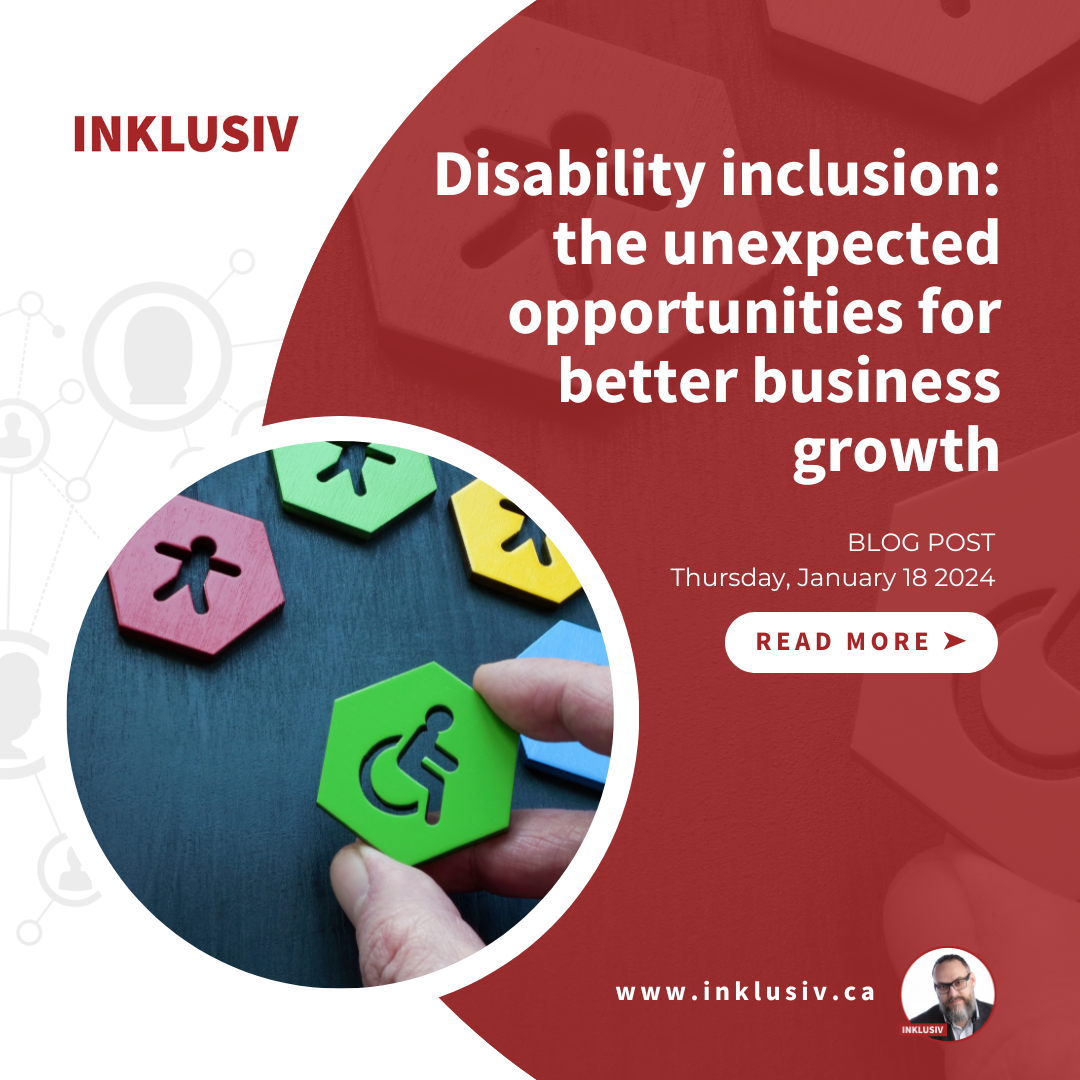Disability inclusion: the unexpected opportunities for better business growth

Diversity, equity, and inclusion (DEI) often focus on gender, race, religion, and sexual orientation – and with good reasons. Yet disability inclusion, a frequently overlooked DEI component, is critical to creating truly welcoming workplaces. If you’re no stranger to this blog, you already know that only about 4% of organizations with DEI policies consider disability as part of their protected characteristics. What this means is that most people living with disabilities are usually very poorly supported in the workplace or as a consumer base – when supported at all…
More than a blatant policy gap, this significant oversight is a missed opportunity for organizational growth, innovation, and connection with a broader audience. It would be tempting to approach it as just another checkbox for social responsibility; as it turns out, disability inclusion is a crucial aspect of a truly diverse and inclusive organization.
Organizations that fail to include people with disabilities in their DEI initiatives not only do a disservice to a significant portion of their workforce but also miss out on the unique perspectives and skills that these people bring. By overlooking this aspect, they build walls, not bridges… These barriers prevent full participation and contribution from all employees. This causes irreparable damage to the organization and, by extension, to their brand.
Recognizing and valuing the diversity of abilities and experiences is what embracing disability inclusion in DEI strategies means. It’s a massive shift in mindset. Going from viewing disability as a challenge to seeing it as an opportunity for enrichment and growth is not something that happens overnight. Organization leaders who want to do better must understand the importance of including disability in their DEI agenda, not just for ethical reasons but for improving their organization’s culture, innovation, and overall success.
The overlooked value of disability inclusion
Viewing disability inclusion as a powerful component of a thriving business environment is one of the common denominators of truly inclusive workplaces. The diversity of viewpoints from those employees bringing unique perspectives based on their lived experiences allows for more innovation, creativity, and problem-solving within their respective teams. Leaders who welcome and nurture such perspectives also have an easier time unlocking a wealth of untapped diverse perspectives, skills, and talents.
In “Rebel Talent (PDF),” a white paper recently published by Harvard Business Review (HBR), we learn that welcoming contributions from employees with diverse perspectives enriches team dynamics and enhances collective capabilities. HBR suggests that leaders who give their teams permission to challenge the status quo and encourage them to think differently empower a more innovative, dynamic, adaptable, and resilient workforce. This type of thinking is also supported by the School Of Meaningful Experiences (SoME). In one of their recent articles on experimentation in the workplace, they even claimed that building a culture of experimentation sparks the discovery of new solutions and opportunities that lead to significant business breakthroughs and competitive advantages.
But disability inclusion doesn’t just benefit organizations internally. This inclusive practice resonates deeply with consumers as well! As a practice, disability inclusion also speaks volumes about organizational values of respect, inclusion and diversity – it’s a powerful commitment to representing and serving diverse markets. These values, incidentally, align with the expectations of a growing percentage of clients and prospects out there craving more meaningful connections with the brands they support. And yes, this includes the 1.3 billion+ people worldwide living with disabilities.
My experience suggests very clearly that organizations which recognize disability inclusion as a valuable driver are the ones positioning themselves as the top leaders in innovation, social responsibility, and business growth – think Apple, Microsoft, Accenture, Ernst & Young and Sodexo, just to name a few… Proving that elevating disability inclusion from a position of moral imperative to a strategic business advantage is a wise business decision.
Challenges of excluding disability in DEI
One of the main messages that I share regularly with my clients is that neglecting disability in DEI strategies leads to significant challenges, both for individuals with disabilities and for the broader organizational culture. Leaders who fail to recognize disability inclusion as a key component of diversity cause employees with disabilities to face unnecessary barriers. Barriers can range from physical access issues to a lack of adaptive technologies and inclusive communication practices. Such barriers hinder these people’s ability to contribute fully – negatively impacting their sense of belonging and value within the organization.
Repercussions of this exclusion extend far beyond individual employees; creating environments where diversity in its truest sense is not fully embraced results in a homogenous culture, inevitably stifling innovation and limiting the organization’s ability to understand and cater to a more diverse customer base.
Furthermore, overlooking disability in DEI efforts sends an implicit message to all employees and stakeholders about the organization’s commitment to true diversity. This positioning certainly leads to lower productivity and higher turnover rates… impacting employee morale and engagement in its own way. Moreover, excluding or dismissing disability inclusion implicitly damages the organization’s reputation, not to be taken lightly; consumers and potential employees increasingly value companies that demonstrate genuine inclusivity.
Disability inclusion as a catalyst for innovation
Organizations like Accenture also believe that disability inclusion is a powerful driver of innovation. Get this: according to their 2018 Research Report titled “Getting to Equal: The Disability Inclusion Advantage (PDF),” organizations that champion disability inclusion were, on average, two times more likely to outperform their peers in terms of total shareholder returns compared with the rest of their peer group. And those that had improved their inclusion of persons with disabilities over time were four times more likely to do so. Four times!
Organizations that embrace the diverse experiences and perspectives of employees with disabilities unlock a wealth of creative potential that can largely be explained by one simple fact: people with disabilities often have no choice but to develop unique problem-solving skills and innovative thinking as they navigate a world that isn’t designed for them. If you want to challenge conventional approaches to solving problems, bring the unconventional perspectives and wisdom of team members with different lived experiences.
Fresh ideas often spring from a mix of different viewpoints. Embracing disability inclusion is a powerful move to unlock creative potential when designing new products, enhancing services, or improving processes – just think of all these objects that were initially created to support people with disabilities… Typewriters and keyboards, speech-to-text and voice recognition applications, curb cuts on sidewalks, bendy straws, and so many more… all of those inventions that are now everyday items initially invented to support people with disabilities. They just happened to become mainstream over time.
Companies that leverage disability as a catalyst for new ideas are ahead of the game. They tap into disability as a creative spark to jump ahead of their competition, thanks to their ability to identify these overlooked opportunities. And back to the top talents we mentioned earlier in this post – building inclusive environments for innovation also has the added benefit of attracting even more of them!
Connecting with a broader consumer base
These competitive advantages are not just internal facing – disability inclusion enhances brand image and customer loyalty since it significantly enhances an organization’s ability to connect with a broader consumer base. Roughly 27% of Canadians and Americans self-identify as having at least one disability. That’s a lot of people to dismiss when your business is about selling a product or service.
Consumers are increasingly conscious of a company’s social impact and commitment to inclusivity; by understanding and addressing the needs of this diverse group, companies tap into a largely underserved market and develop even stronger connections with their audiences and markets. If this doesn’t drive business growth, brand loyalty, and reputation, then I don’t know what does!
Inclusive businesses are better equipped to understand the subtle nuances of accessibility and usability in their products and services. This particular sensitivity leads to further innovations that resonate with people with disabilities as well – it makes their products more appealing and accessible to them and everyone else. After all, intentional inclusive design practices applied to websites and applications result in more user-friendly interfaces that benefit all users, not just those with disabilities.
But beyond disabilities and those who live with them, consumers today are increasingly socially conscious than ever before: a recent Nielsen report by Nielsen that surveyed 30,000 consumers in 60 countries also found that 66% of consumers were willing to pay more for goods from brands that demonstrated social commitment to inclusivity and social responsibility.
Integrating disability inclusion for business growth
An inclusive workplace based on acceptance and respect is more likely to breed a productive and motivated workforce that feels valued and included. Such a commitment from the team naturally contributes to the overall success of the business – think higher degrees of employee engagement, job satisfaction, and talent retention.
Along with recognizing those who are usually invisible or dismissed, perhaps one of the most strategic and powerful moves you can make towards sustainable growth and cultural transformation as a leader is integrating disability inclusion into your organization’s DNA. Embracing diversity in its truest form allows the organization to harness disability inclusion and funnel it for success. It makes disability inclusion an indisputable component of business growth and a force to be reckoned with!
Of course, environments of creativity, problem-solving, and inclusivity are more easily envisioned than achieved! For many leaders, this process begins with an actual acknowledgment of the existence of employees with disabilities within their ranks (as well as the unique contributions and potential that they bring), even when those folks excel at hiding in plain sight! As this recognition extends beyond your workplace and spills into your marketplace, your perspectives about representation will also broaden.
Through that process, your understanding of how your organization can best meet the needs of a more diverse customer base will also expand. That is the one promise I make to you.
This week’s mission, should you accept it…
This week, take some time to reflect on your organization’s DEI initiatives and projects. Are you truly including disability in your policies and your frameworks? If not, then it’s time to make a change! Start by setting clear goals. Involve key stakeholders in the conversations. If you’re unsure where to start, don’t fret, I’ve got your back! Explore previous posts from the Info-Hub section and download my 15 keys to unlocking a diverse and empowered workplace for a disability inclusion and leadership roadmap.

About Denis Boudreau
Denis Boudreau is a consultant, trainer, coach, and speaker specializing in inclusive leadership and inclusive communication. He works with leaders and executives who are no longer willing to overlook disability inclusion and want to transform their leadership approach from “inclusive-ish” to truly inclusive by championing accessibility. A Certified Professional in Web Accessibility (CPWA), Denis has trained thousands of professionals over the past two decades and has delivered hundreds of workshops worldwide in both English and French. He has helped leading brands like Netflix, Salesforce, Victoria’s Secret, and many more embed disability inclusion into their business strategies, empowering them to break down barriers and create deeper, more meaningful connections with their target audiences while also meeting legal obligations.